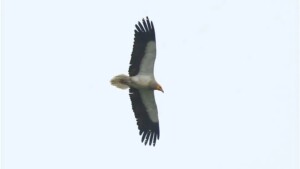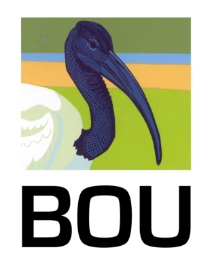Changes to the British List (27 March 2025)
The British Ornithologists’ Union Records Committee (BOURC) has changed the category of a species on the British List.
The following species has been moved from Category BDE to Category AE of the British List:
 Egyptian Vulture Neophron percnopterus percnopterus
Egyptian Vulture Neophron percnopterus percnopterus
One, fifth-calendar-year or older, Willingham by Stow, Lincolnshire, 13 May 2021 (photographed); presumed same Peninnis Head, Longstone, and Telegraph, St Mary’s, Isles of Scilly, 14 June 2021 (photographed); and Great Pool and Carn Near, Tresco, Isles of Scilly, 14 June 2021 (photographed); presumed same, sixth-calendar-year or older, Restronguet Creek, Devoran, Cornwall, 22 May 2022 (videoed).
Photo (right): Egyptian Vulture © Scott Reid
This Egyptian Vulture Neophron percnopterus was initially discovered in North Lincolnshire, with what was assumed to be the same individual relocated the following month on the Isles of Scilly. In both instances the bird was photographed, although the images obtained in Lincolnshire were of very poor quality and did not allow confirmation that it was the same individual as that on the Isles of Scilly. However, based on plumage characters the same Egyptian Vulture which was present on the Isles of Scilly on 14 June 2021 was later relocated in Ireland between 14 July 2021 and 6 May 2022 in counties Donegal, Mayo, and Roscommon. It was subsequently accepted onto Category A of the Irish List (Irish Birds 45:64, O’Donaill 2024). On 22 May 2022 what was presumed to be the same Egyptian Vulture, seemingly retracing its earlier movements, reappeared in Britain in southeast Cornwall. The video evidence did not allow absolute confirmation that the same individual was involved, but it was decided by consensus of the Committee that all these records should be treated as the same individual.
Egyptian Vulture is polytypic with three subspecies recognised: ginginianus, majorensis, and nominate percnopterus (IOC World Bird List v15.1). The morphology of the 2021-2022 individual was incompatible with ginginianus and the restricted range (eastern Canary Islands), small population and sedentary nature of majorensis allowed the subspecies involved to be accepted as nominate percnopterus (Biol. Conserv. 107:89–97).
Egyptian Vultures of the nominate subspecies breed in southern Europe, the Middle East and Africa, and are largely migratory wintering in Africa (IOC World Bird List v15.1), although increasingly some individuals are wintering within their breeding range in Europe (Ethol. Ecol. Evol. 36:663-678, Sci. Rep. 10:17690).
Within Europe, Egyptian Vulture is accepted as a vagrant well north of its range with records in northern France, Belgium, Netherlands, Germany, Denmark, Poland, Norway, Sweden, Finland, and Estonia. The month of discovery of the British record accords well with the typical occurrence of spring vagrants of this species in northern Europe, a majority of which have involved birds in adult-type plumage. However, the extended stay made by this individual is highly unusual. Individual Egyptian Vultures with adult-type plumage are not necessarily sexual mature, with female and male Egyptian Vultures showing a median age of first reproduction of six and seven years respectively. This means that ‘adult-plumaged’ birds (from five years) can essentially still be biologically immature and still prospecting for nest sites – which is likely to happen from 4-8 years of age (Sci. Rep. 7:40204) and is the likely driver of vagrancy in this instance (Ron Efrat in litt.).
Like many large raptors, Egyptian Vultures tend to avoid significant sea-crossings if they can, for example high mortality rates stemming from failed sea-crossings have been demonstrated in both the reintroduced Italian population (Bird Conserv. Int. 33:e13) and in the Balkan Peninsula (Ibis 157:545-557). So, although Egyptian Vultures may be more likely to undertake sea-crossings than some other large raptors, as is evidenced by their historical colonisation of the Canary Islands and vagrancy to other island groups, they are still reticent to do so. So, a long stay by a vagrant Egyptian Vulture on islands in north-west Europe may reflect this behavioural reticence to undertake an extensive over-water movement. This may have effectively marooned the individual in Ireland until such a time that its internal zugunruhe peaks and drives relocation again in spring, a period which may also coincide with appropriate anticyclonic weather windows to facilitate over-water movements.
Egyptian Vulture is held in captivity in multiple collections in Britain and has been proved or presumed to have escaped here on several occasions historically (including in Hampshire and then Sussex in 1969, Carmarthenshire, Ceredigion, Cornwall, Norfolk, and Dorset in 2012, and Warwickshire in 2018 and 2020) (Ibis 142:177-178). To better understand the current escape risk, BOURC sought the professional opinion of Adam Bloch, CEO of the Horstmann Trust (a vulture conservation charity). Adam indicated that there are around 30 Egyptian Vultures held in the UK in private collections and that most of these birds are likely to be unringed, as rings suffer from wear and build-up of excreta, but that any birds that are regularly flown are likely to be microchipped or have telemetry equipment. Adam suggested that there is likely to be as much variation in behaviour (e.g. fear of humans, propensity to wander) among wild and captive individuals than between them, such that behaviour in the wild is unlikely to be a reliable signal of a captive origin.
However, Adam highlighted a number of characteristics that ought to reliably separate wild individuals from escaped captive individuals. Indicative signs of captivity include damaged rectrices and asymmetrically worn remiges (due to the particular nature of their behaviour in an aviary), in addition to damage to the cere, and/or overgrown mandibles and claws. Egyptian Vultures are expensive, around ~£8000 each, such that owners are likely to make very significant efforts to recapture lost birds via social and legacy media – as has happened in the past and no UK escapes were reported in the period (per the Independent Bird Register). Given the absence of any of these markers of captivity in the 2021-2022 individual it was unanimously accepted as a wild vagrant by the Committee.
Previously Egyptian Vulture was on the British List on Category B based on singles at Kilve, Somerset in October 1825 and at Peldon, Essex on 28 September 1868, and on Category D on the basis of a 5CY+ in Hampshire at Black Down, Denny Wood, and Matley Heath on 16 June 1968 (Ibis 142:177-178, Ibis 154:214). The latter occurrence has previously been reviewed by the Committee and whilst the identification is accepted it was found not to be acceptable as a first Category A record due to the nature of the sighting not allowing the determination of subspecies, or the presence of rings or anklets, or for any assessment of traits indicative of captivity to be made. It also occurred the year before an escaped Egyptian Vulture was present in the same county; this record is consequently now moved to Category E (Ibis 154:214).
This change will be published as part of the BOURC’s 58th report due to be published in Ibis in January 2026. Upon publication of this change, the British List stands at 640 species (Category A = 623; Category B = 7; Category C = 10).


